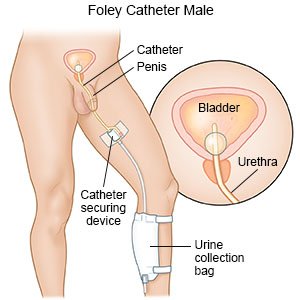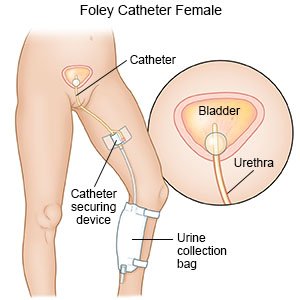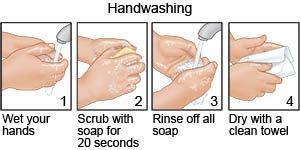Foley Catheter Placement and Care
Medically reviewed by Drugs.com. Last updated on Aug 4, 2025.
What is a Foley catheter?
A Foley catheter is a thin, flexible, sterile tube that drains urine from your bladder. It is also called an indwelling urinary catheter. The tip of the catheter has a small balloon filled with solution that holds the catheter in your bladder.
 |
 |
How is a Foley catheter placed?
Your healthcare provider will clean your genital area to prevent infection. Your provider will insert the catheter into your urethra. When urine begins to flow into the tubing, the balloon is filled to keep the catheter in place. The open end of the catheter is attached to a drainage bag. Urine drains from your bladder, through the tube into the drainage bag.
Why is catheter care important?
An infection can develop when bacteria get inside the catheter or drainage system. This can happen when the urine bag is changed or when a urine sample is collected. You can get an infection if you do not wash your hands. You can also get an infection if the catheter equipment is not cleaned properly. Urinary catheter-based infections can lead to serious illness. The following can help prevent infection:
- Care for your catheter as directed. Follow directions on how to clean and care for your catheter, insertion site, and drainage bag.
- Wash your hands often. Always wash with soap and water before and after you touch your catheter, tubing, or drainage bag. Wear clean medical gloves when you care for your catheter or disconnect the drainage bag. This will help stop germs from getting into your catheter. Remind anyone who cares for your catheter or drainage system to wash his or her hands.

- Clean your genital area. Wash the catheter area 2 times every day. Wash your anal opening after every bowel movement. Use a soapy cloth to clean the area:
- If you are male, clean the tip of your penis. Start where the catheter enters. Wipe backward, making sure to pull back the foreskin. Then use a cloth with clear water in the same direction to clean away the soap.
- If you are female, clean the area where the catheter enters your body. Separate your labia (the smaller folds of your skin around your vaginal opening) and wipe toward the anus. Then use a cloth with clear water and wipe in the same direction.
- Secure the catheter tube. Healthcare providers will show you how to use medical tape or a strap to secure the catheter tube to your leg. Do not pull or move the catheter. This helps prevent pain and bladder spasms.
- Drink liquids as directed. This will help keep your urine clear and prevent catheter blockage and infection. Good choices for most people include water, juice, and milk. Ask how much liquid to drink each day and which liquids are best for you.
Related medications
How do I care for my drainage bag?
You will use a leg bag during the day. You may need a larger drainage bag at night.
- Keep a closed drainage system. Your catheter should always be attached to the drainage bag to form a closed system. Do not disconnect any part of the closed system unless you need to change the bag.
- Position the drainage bag properly. Keep the drainage bag below the level of your waist. This helps stop urine from moving back up the tubing and into your bladder. Do not loop or kink the tubing. This can cause urine to back up and collect in your bladder. Do not let the drainage bag touch or lie on the floor. Do not lie down or sleep with your drainage bag attached to your leg.
- Empty the drainage bag when needed. The weight of a full drainage bag can pull on the catheter and cause pain. Empty the drainage bag every 3 to 6 hours or when it is ⅔ full.
- Clean and change the drainage bag as directed. Ask your healthcare provider how often you should change the drainage bag and which cleaning solution to use. Wear disposable gloves when you change the bag. Do not allow the end of the catheter or tubing to touch anything. Clean the ends with an alcohol pad before you reconnect them.
What can I do if problems develop?
- No urine is draining into the bag:
- Check for kinks in the tubing and straighten them out.
- Check the tape or strap used to secure the catheter tube to your skin. Make sure it is not blocking the tube.
- Make sure you are not sitting or lying on the tubing.
- Make sure the urine bag is hanging below the level of your waist.
- Urine leaks from or around the catheter, tubing, or drainage bag: Check if the closed drainage system has accidently come open or apart. Clean the catheter and tubing ends with a new alcohol pad and reconnect them.
When should I seek immediate care?
- Your catheter comes out.
- You suddenly have material that looks like sand in the tubing or drainage bag.
- You see blood in the tubing or drainage bag.
- Little or no urine is draining into the bag, and you have checked the system.
- You have pain in your hip, back, pelvis, or lower abdomen.
- You are confused or cannot think clearly.
- You see swelling, redness, pus, or burning where the catheter goes into your body.
When should I call my doctor?
- You have a fever or shaking chills.
- You have bladder spasms for more than 1 day after the catheter is placed.
- Your urine has a strong smell.
- You have a rash or itching where the catheter tube is secured to your skin.
- Urine leaks from or around the catheter, tubing, or drainage bag.
- The closed drainage system has accidentally come open or apart.
- You see a layer of crystals inside the tubing.
- You have questions or concerns about your condition or care.
Care Agreement
You have the right to help plan your care. Learn about your health condition and how it may be treated. Discuss treatment options with your healthcare providers to decide what care you want to receive. You always have the right to refuse treatment. The above information is an educational aid only. It is not intended as medical advice for individual conditions or treatments. Talk to your doctor, nurse or pharmacist before following any medical regimen to see if it is safe and effective for you.© Copyright Merative 2025 Information is for End User's use only and may not be sold, redistributed or otherwise used for commercial purposes.
Further information
Always consult your healthcare provider to ensure the information displayed on this page applies to your personal circumstances.
